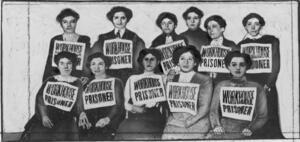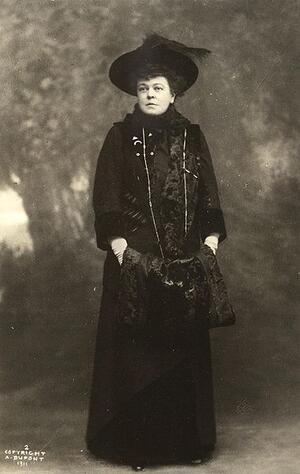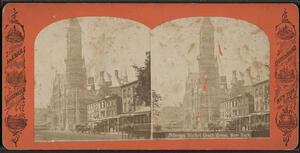Jefferson Market Courthouse

Many arrested shirtwaist strikers were brought to Jefferson Market Courthouse, tried, and given harsh sentences. These women, arrested on the picket lines circa 1910, were sent to Blackwell’s Island (presently Roosevelt Island) to serve out their sentence. In this photograph, they proudly wear signs reading Workhouse Prisoner. Arrested shirtwaist strikers wearing signs that read "Workhouse Prisoner."
Courtesy of the International Ladies' Garment Workers' Union Archives, Kheel Center, Cornell University.
Today a branch of the New York Public Library, in 1909 this handsome building served as night court for striking garment workers arrested for picketing. Once here, the strikers could expect to face unsympathetic magistrates who did not hesitate to hand down harsh sentences. Hoping to increase public support and publicity about the treatment strikers received, reformers and society women joined the picket lines. Some even spent the night at the courtroom and provided the necessary funds for bail.
The Tammany political machine, which controlled politics in New York City, sided with the factory owners and looked the other way when they hired scabs, thugs, and prostitutes to disrupt orderly picket lines. An assistant cashier at the Triangle Factory recalled that, “you could get a man on the beat to look away by giving him a box of cigars with a $100 bill in it. Then the hoodlums hired by the company could do their work without interference. They couldn’t hit women, even on the picket line. So they brought their lady friends-prostitutes. They knew how to start fights.”

Alva Belmont (Alva Ertskin Smith Vanderbilt Belmont, née Alva Ertskin Smith, also called (1875–96) Alva Vanderbilt) was a wealthy American socialite and an outspoken suffragette.
This portrait of Belmont was taken by the Stadler Photographing Company in 1911.
Courtesy of the United States Library of Congress, Prints and Photographs Division.
Despite the fact that it was perfectly lawful to picket peacefully, hundreds of women were fined or jailed on charges such as vagrancy, solicitation, disorderly conduct, and assault. Recognizing the abuse that strikers suffered at the hands of police and the violation of their rights, middle-class members of the Women’s Trade Union League (WTUL) sought to publicize the plight of their working-class sisters. WTUL women joined the picket lines, hoping to dissuade police from unlawful arrests or abusive behavior. When police mistakenly arrested WTUL members, including on one occasion the League’s president Mary Dreier, public opinion shifted to the side of the striking women.
In December 1909, the wealthy suffragist Alva Belmont spent an evening observing the proceedings at the Jefferson Market Courthouse. Adorned with furs and a large black hat with feathers, Belmont sat for hours on a hard wooden bench. She watched through opera glasses as the magistrates dealt with a series of petty criminals. Just before midnight, police began to bring in striking garment workers; their offense had been yelling ‘scab’ at strikebreakers.
Several hours later, four more strikers were brought in; their bail was set at $100 each. Alva Belmont offered to pay the $400. Since she did not have the full amount with her, the judge was required to ask whether she had property worth at least twice that amount above and beyond any debts. Mrs. Belmont offered her Madison Avenue mansion — worth nearly half a million dollars.
Belmont’s offer to use her mansion as collateral for striking workers was a public relations triumph for the strikers. The New York World wrote, “For almost the first time women of widely different social ranks have joined forces in the common cause which, though directly for the betterment of one element, is for the ultimate political advancement of all.”



